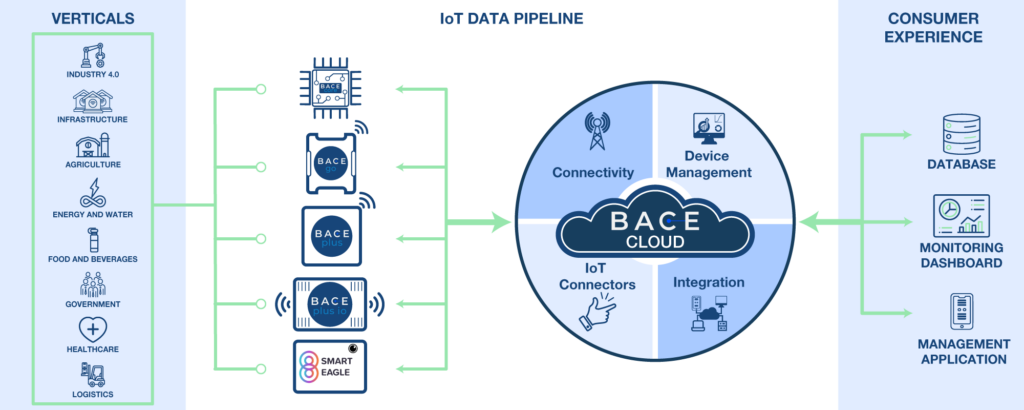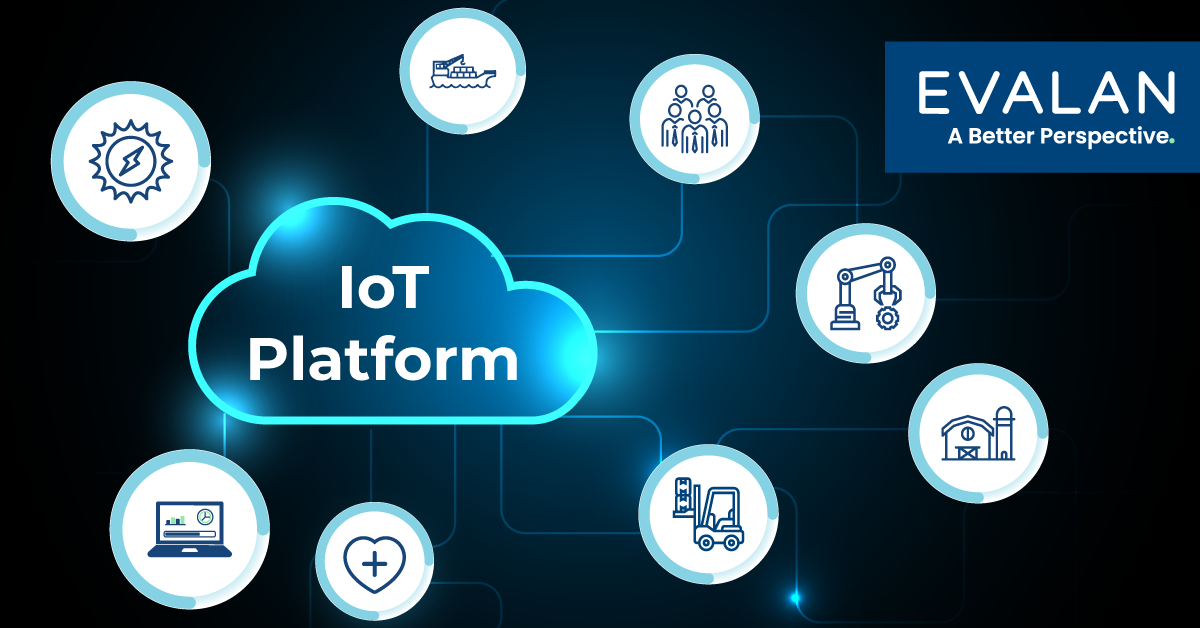In technology, the term platform is a grouping category used to refer to a set of components that allow an individual to develop a product. Since everyone describes and defines “platform” differently, it is common to wonder what an IoT platform really is, what types there are, what they cover, and which type one would need.
This article will attempt to shed light on the topic.
Index
- IoT Platform types (device, connectivity, cloud, analytics, end-to-end)
- EVALAN’s edge-to-cloud platform
- BACE IoT Gateways
- Connectivity
- BACE Cloud & BACE Panel
- Integration
- More information
IoT Platform
IoT platforms are like technology platforms in the sense that they provide the building blocks that a business can use to create a variety of wider applications or connected products. An IoT platform is a toolset that provides the infrastructure and functionalities that businesses need to bridge the gap between physical devices and data networks.
IoT platforms have different capabilities and provide different services depending on what they were built for. The aim of an IoT Platform will always be to add value to the customer by reducing development risks and costs, and accelerating time to market. IoT platforms can be generally categorized in:
- IoT device platforms serve as foundational tools for developing IoT hardware, such as physical devices like IoT Gateways. These platforms provide the necessary building blocks, including microcontrollers, microprocessors, Systems on Chip (SoC) and Systems on Module (SoM), to simplify and accelerate the process of creating IoT devices.
- IoT connectivity platforms seamlessly manage the connectivity between the devices on-the-ground and the cloud so that information can be transmitted between them. Popular communication protocols include Modbus, Bluetooth, ZigBee, LoRa, Z-Wave, CAN bus and more.
- IoT cloud platforms/application enablement platforms provide the core infrastructure for a product as they focus on the data stream part, including consuming, transporting, storing, analyzing, and integrating data. These platforms provide tools to monitor, troubleshoot and update connected on-the-ground devices remotely. They handle IoT Gateways and device onboarding, configuration, monitoring and management in real time.
- IoT analytics platforms use advanced algorithms to analyze the collected data in-depth and over time and transform it into actionable insights for the businesses leveraging IoT through their connected products.
- End-to-end IoT platforms cover all aspects of IoT products, from development and connectivity to data management and visualization through a dashboard.
The Internet of Things is a multi-layered system, which makes its technology stack and architecture complex. Because of that, IoT providers began to “specialize” in one part of the puzzle. As seen from the above-mentioned categorization of platforms, some providers focus on the IoT gateways, some on providing connectivity services and some on cloud. This, however, creates several problems for the client who is then stuck having to use more than one IoT platform for their product and hence might find they are:
- Lacking a single point of ownership when things go wrong.
- Lacking seamless integration from their device all the way to the cloud.
A good IoT platform is one that saves the customer most time and money by streamlining complexity and seamlessly covering the most crucial link of the IoT chain. This means a platform that fully integrates the entire IoT data pipeline (platforms 1-3 edge-to-cloud).

EVALAN’s IoT platform
EVALAN’s IoT platform BACE (Build A Connection Everywhere) is the edge-to-cloud platform created to provide customers with an integrated service so that they can focus on their connected product and business.
BACE tightly integrates into a single service the key infrastructural components needed to create a connected product. These infrastructural components include our BACE IoT Gateway, software, connectivity, cloud device management tools, security, and integrations needed to consume the critical data collected from the field in whichever way wanted.

BACE IoT Gateways
To help customers easily address cross-device and cross-system compatibility, EVALAN created multifunctional IoT Gateways (available in the market in different models) with several built-in protocols. The result: customers can create a wide range of products for diverse use cases without having to write code.
Furthermore, because the security of an IoT deployment depends on the protection of all its components, EVALAN implements security from the design stage at device and cloud level. All BACE Gateways are secured through flash encryption, firmware encryption, secure boots and identity certificates to connect to the BACE Cloud.
Connectivity
Each BACE IoT Gateway (BACE Core, BACE Plus, BACE Plus IO and BACE Go) is shipped with a built-in e-Sim card with global connectivity. Connectivity is managed by EVALAN so customers can rest assured that their assets are seamlessly connected to the BACE Cloud, and do not have to worry about the details of it (e.g., via LTE-M, Ethernet, or Wi-Fi).
BACE Cloud & BACE Panel
BACE uses the IoT Hub of the Microsoft Azure Cloud and adds several BACE-specific functions including Over-The-Air updates, data storage and a Restful API to provide a comprehensive service.
The BACE Cloud has a digital twin of each BACE Gateway to provide insights into the state of each Gateway at any time. Through BACE Panel, our device management portal, the health status of the entire IoT data pipeline can be overseen and all devices can be managed, monitored, and configured.
At cloud level, security is divided into several layers including separate security for data in rest and data in transit. Data in transit is encrypted following several protocols and data in rest secure passwords, roles and permissions are implemented. Furthermore, all information is isolated and kept in a private network.
Integration
The information extracted from the devices in the field is organized, orchestrated, and stored (by default for 90 days with extension options up to 10 years) before being integrated into a customer’s own desktop/mobile application, database, or system. The data can also be easily integrated into an analytics platform.
The integration of all the data is done via an API (Application Programming Interface) and/or Webhook. As opposed to Webhook integration (which is one-directional), API integration is typically done to set up bi-directional communication between the assets and the BACE Platform and hence enable remote control of devices in the field. In that sense, the method of integration is chosen by the customer based on their architecture, use case, and the weighing benefits for each method, for example:
- The advantage of an API integration is that the information is stored on the BACE Platform so our customer’s technical stack will be leaner.
- The advantage of a Webhook over an API is that the former requires less computational power from our customer.
For more information
For more information about EVALAN’s comprehensive IoT Platform as a Service, send us an email to info@evalan.com.
Or book a meeting with us here.
